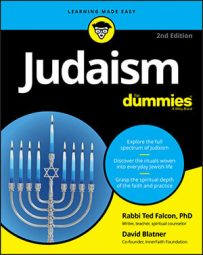Jewish weddings are performed under a chuppah, a canopy held over the heads of the bride and groom. The chuppah can be anywhere. In fact, an old Ashkenazi custom holds that you should perform the wedding outside if possible.
Although many people like the idea of being married in a “House of God,” Jewish teachers have long insisted that God can be found in any house and, in fact, anywhere at all. The trick isn’t looking for a holy place to get married, but rather to create a holy space.
The chuppah — a symbol of the new home being created, and, some say, a symbol of the tents used by the ancient Hebrews — can be as simple or as elaborate as you’d like.
Many people use a swath of cloth (often a tallit, or prayer shawl), held aloft with four poles by friends of the couple (it makes things easier if the poles reach to the ground). Others decorate the chuppah with flowers or embroidery, or use a self-standing awning.
One relatively recent custom is to have someone coordinate the construction of the chuppah from squares of material given out to some friends of the couple. After those friends add their own decorations, words, drawings, and colors to the squares, they are then made into a quilt. Following the ceremony, the quilt can become a wall hanging in the couple’s home to remind them of their wedding ceremony.
One of the stranger traditions at a Jewish wedding is the bride circling the groom either three or seven times (seven is more traditional) as soon as they’re under the chuppah. This tradition may be a holdover from earlier, more superstitious times, when people believed that circling would create a magic shield against evil spirits. Or perhaps it was simply a symbol of binding the two people together.
Today, many Jews think it makes the woman look subservient to the man, so they leave the practice out entirely. Others have the groom do it, too, or have the bride and groom circle each other.

